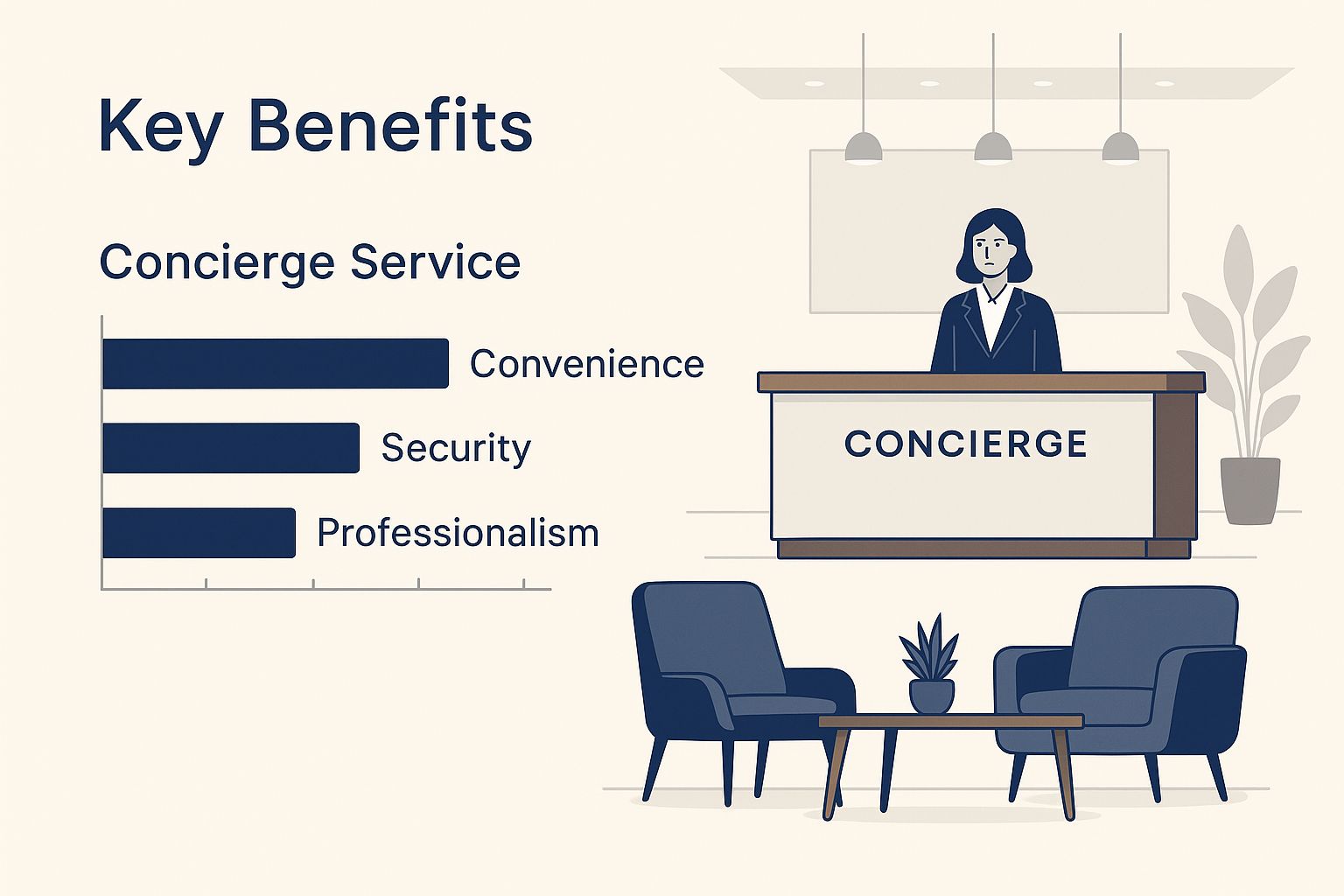What Is a Class A Building? A Guide for Discerning Investors
- Ryan McDowell

- Aug 6
- 11 min read
Reading Time: 7 min | Good for: Novice Investors (A), Informed Principals (B)
TL;DR: The Bottom Line on Class A Real Estate
What is it? Class A properties are the highest-quality buildings in their market, defined by prime locations, superior construction, modern amenities, and professional management. They command the highest rents and attract the best tenants.
Why should investors care? These assets are prized for their stable cash flow, low vacancy rates, and strong potential for appreciation, making them a cornerstone for capital preservation and long-term growth.
What's the catch? The primary risks are a higher purchase price and sensitivity to broad economic downturns. Mitigation comes from sponsors who secure long-term leases with high-credit tenants.
How do you access them? While direct purchase is capital-intensive, accredited investors can gain access through passive investments in private equity funds and syndications.
So, what exactly is a Class A building? Think of it as the "greatest hits" album in a real estate portfolio. These properties are the absolute best buildings in their specific market, commanding premium rents and attracting top-tier tenants for a reason. They have the best locations, the best construction, and the most modern amenities.
Defining a Class A Property: The Best in Its Market

For investors looking for a powerful blend of stability and growth potential, understanding this asset class is non-negotiable. Class A properties are the most prestigious and sought-after assets in commercial real estate, often forming the bedrock of institutional portfolios from global family offices to pension funds. According to a 2023 survey by Preqin, over 80% of institutional investors plan to maintain or increase their real estate allocations, often targeting core assets like Class A.
But it’s not just about shiny architecture. These buildings are defined by a specific set of characteristics that drive their value and, ultimately, their performance. While the exact standards can shift from city to city—whether it’s an office, apartment building, or retail center—the core principles hold true.
The Core Attributes of a Class A Asset
A building’s classification is always relative to its local market. What qualifies as a Class A tower in a secondary city might look different from one in a global hub like New York, but it will always be among the very best options available in that location.
To give you a clearer picture, here’s a summary of what sets these properties apart.
At-a-Glance Characteristics of Class A Real Estate
Prime Locations: Situated in central business districts (CBDs) or desirable, high-barrier-to-entry submarkets with excellent access to transportation and amenities.
Superior Construction & Finishes: Built with high-quality materials, state-of-the-art systems (HVAC, elevators, security), and premium interior and exterior finishes.
Modern Amenities: A rich amenity package designed to attract and retain high-caliber tenants, such as fitness centers, conference facilities, sophisticated common areas, and smart-building technology.
Professional Management: Maintained and operated by reputable, institutional-grade property management firms that ensure tenant satisfaction and operational efficiency.
Novice Lens: Think of it this way—if a city were a country club, the Class A building is the championship golf course. It’s perfectly manicured, offers the best experience, and everyone wants to be there.
Essentially, Class A buildings are generally under 15 years old or have undergone significant renovations to compete with new construction. This powerful combination of attributes leads to higher property values and more predictable cash flow, making them a cornerstone for any serious investor. If you want to dive deeper, you can explore our full guide to commercial building classes.
The Financial Performance of Class A Real Estate
Beyond the prestige, what does a Class A investment actually do for your portfolio? This is where the real story is. The premium physical qualities of these buildings translate directly into more predictable, superior returns for investors seeking both stability and long-term growth.
The biggest financial draw is their exceptionally stable cash flow. This isn't by accident. It's the result of attracting and retaining high-credit tenants—think Fortune 500 companies, major law firms, or national medical groups. These tenants don't just pay rent; they sign long-term leases and are far less likely to default, which drastically cuts down on turnover costs and keeps the income stream reliable.
Low Vacancy and High Demand
That reliable income is further protected by consistently low vacancy rates. When the market gets competitive, Class A properties are the first to get leased and the last to be emptied. Their desirability creates a deep and persistent demand that often keeps occupancy well above the market average, insulating the investment from minor economic bumps in the road.
You can see their market dominance in the numbers. Class A buildings typically command rental premiums anywhere from 20% to 50% higher than Class B and C properties in the same area, according to data from firms like JLL and CBRE. That premium is a direct reflection of their superior quality.
Capital Appreciation and Lower Risk
Finally, let's talk about long-term value. Class A real estate offers significant potential for capital appreciation. These are the assets that institutional buyers like pension funds and REITs are always hunting for, which keeps them liquid and pushes their value up when it’s time to sell. This high demand, combined with stable income, means they are widely seen as lower-risk investments.
This powerful mix of steady income and strong growth potential is why institutions love them. To see how this compares to other asset types, you can explore the different classes of property in real estate. It's this full package of financial advantages that makes Class A real estate a cornerstone of so many sophisticated portfolios.
How Class A Compares to Class B and C Properties
To really understand the strategic value of a Class A asset, it helps to see how it stacks up against its peers. The commercial real estate world is generally split into three tiers—Class A, B, and C. Each has its own distinct role in an investor's portfolio, defined by a unique risk-reward profile.
Let's use a simple analogy. Think of it like buying a car.
A Class A property is the brand-new, top-of-the-line luxury sedan. It’s reliable, stylish, and packed with the latest tech. It promises a smooth ride with minimal headaches but, as you’d expect, it comes with a premium price tag.
A Class B property is more like a dependable, well-maintained used car from a reputable brand. It’s still in a good neighborhood and gets the job done, but it might lack the prestige and cutting-edge features of the newest model. It’s a solid performer that offers a chance to add value with a few smart upgrades.
A Class C property is the vintage project car. It’s usually in a less desirable area and needs a lot of work. The initial cost is low, but it demands significant time, capital, and expertise to get it running smoothly. The potential payoff is high, but so is the risk of a major breakdown along the way.
Strategic Investor Trade-Offs
The choice between these classes comes down to one thing: your investment goals.
If your focus is on capital preservation and steady, reliable income, you’ll naturally be drawn to Class A assets. The higher price is a worthwhile trade-off for lower risk, premium tenants, and cash flow you can count on.
On the other hand, if you're chasing an opportunistic or value-add strategy, you might find yourself looking at Class B or C properties. These assets have a lower barrier to entry and offer the chance for higher returns through renovations, repositioning, and hands-on management. Of course, this path comes with more risk—think higher vacancy rates, more intensive management needs, and greater sensitivity to economic bumps in the road.
For a deeper dive into these differences, you can check out our guide comparing Class A vs Class B real estate.
This graphic breaks down the key benefits that really set Class A properties apart from the pack.

As you can see, the blend of a prime location and superior quality creates a powerful defense against market volatility.
Property Class Comparison Class A vs B vs C
To make these distinctions even clearer, here's a side-by-side comparison. This table breaks down the core characteristics that define each property class for an investor.
Feature | Class A | Class B | Class C |
|---|---|---|---|
Building Age | Typically <15 years old | Typically 15-25 years old | Typically >25 years old |
Location | Prime, central business district | Good, but not prime | Less desirable areas |
Tenant Quality | High-credit, national tenants | Mix of tenants, good credit | Smaller, local tenants |
Amenities | High-end, modern finishes | Good, but dated | Basic or non-existent |
Rental Rates | At or above market rate | Average market rate | Below market rate |
Investment Risk | Low (Core) | Moderate (Core-Plus) | High (Value-Add/Opportunistic) |
Investor Profile | Capital Preservation, Income | Balanced Growth & Income | High Growth, Higher Risk |
Ultimately, understanding these differences is what allows you to place your capital strategically, aligning your investments with your personal tolerance for risk and your desired returns.
Deal Lens Example: The Class A Office Tower
Let's put some real-world context on this. Theory is one thing, but seeing how a deal actually comes together is what matters.
Picture this: a stunning, 30-story glass office tower right in the heart of a bustling downtown. This isn't just a building; it's a prime Class A investment. A sponsor firm, like us at Stiltsville Capital, acquires the property with a clear business plan to maximize its value for the passive investors who've put their capital into the deal.
The Capital Stack (Illustrative)
Purchase Price: $100M
Senior Debt (Loan): $65M (65% LTV)
LP Equity (Your Investment): $30M
GP Equity (Sponsor "Skin-in-the-game"): $5M
How You Make MoneyThe game plan here is straightforward but requires expertise. It’s a two-pronged approach: creating steady income while also increasing the property's underlying value.
Income from Top-Tier Tenants: The building is leased to reliable, financially strong tenants—think a national law firm or a fast-growing tech company. They sign long-term leases, often for 7-10 years, that include built-in rent increases (e.g., 3% annually). This creates a predictable and growing stream of cash flow for investors, paid out as quarterly distributions.
Forcing Appreciation for a Capital Gain: After a 5-7 year hold period, the plan is to sell the property. The sale price is determined by its Net Operating Income (NOI). By managing the property efficiently—keeping it fully leased, controlling costs, and securing those rent bumps—the sponsor directly boosts the NOI. A higher NOI at sale means a higher exit price and a significant capital gain for investors.
Investor Takeaway: Investing in a Class A office tower isn't just about buying four walls and a roof; you're backing a business plan. The sponsor's skill in leasing, management, and knowing exactly when to sell is what turns a beautiful building into real, tangible returns for investors.
This is a simplified look, of course, but it captures the essence of how institutional-grade real estate investing works. If you want to dive deeper into the nuts and bolts, check out our full guide on [how to invest in commercial real estate](https://www.stiltsvillecapital.com/post/how-to-invest-in-commercial-real-estate-a-2024-guide).
Key Questions to Ask Before Investing in a Class A Deal

A glossy brochure and an impressive pro forma are just the start. The savviest investors know the real story of a Class A deal is found in the answers a sponsor gives to tough, direct questions. Before you consider committing capital, you must probe beneath the surface.
This isn’t about being difficult; it's about conducting the kind of rigorous diligence that institutional players do. A seasoned sponsor will welcome these questions as a chance to demonstrate their expertise.
Checklist: Questions for Your Sponsor
The Deal and The Market
Tenant Strategy: What is the current rent roll and lease expiration schedule? What is the credit quality of the anchor tenants?
Submarket Demand: What are the key economic drivers in this specific submarket? What is the five-year forecast for new supply that could compete with this asset?
Capital Plan: What is the detailed budget for capital expenditures (CapEx)? Does it include a healthy contingency for unexpected repairs or tenant improvements?
The Numbers and The Risks
Debt Structure: What are the loan terms? Is the interest rate fixed or floating, and what is the plan if rates rise?
Return Projections: What are the key assumptions (rent growth, exit cap rate)? How do returns hold up in a downside scenario (e.g., 10% lower rents, 50 bps higher exit cap)?
Sponsor Alignment: How much of your own capital ("skin in the game") is in this deal? How is your compensation (the "promote") structured to align your interests with investors?
These questions are your starting point. For a deeper dive, check out our complete [guide to commercial real estate due diligence](https://www.stiltsvillecapital.com/post/a-guide-to-commercial-real-estate-due-diligence-the-investor-s-playbook). Armed with the right questions, you can truly assess whether a Class A opportunity is as solid as it looks.
Understanding and Mitigating Class A Risks
No investment is ever risk-free, and that holds true for the top tier of commercial real estate. While Class A assets are sought after for stability, a smart investor always looks at the potential downsides.
Risk & Mitigation Table
Risk: Economic Sensitivity * In a downturn, companies may downsize, impacting demand for premium-priced space.
Mitigation: Long-Term Leases with Credit Tenants * A sponsor's best defense is securing high-credit tenants on long-term leases (7-10 years) with staggered expirations. This creates a durable income stream that can withstand short-term market volatility.
Risk: New Supply Competition * The very success of a market can attract new development, creating more Class A buildings that compete for the same tenants.
Mitigation: Deep Submarket Diligence * A sponsor must prove they’ve analyzed the development pipeline to ensure the submarket has strong, lasting demand drivers that can absorb new supply without depressing rents.
Risk: Overpaying at the Peak * The prestige of Class A assets can lead to competitive bidding, pushing prices to levels that are hard to justify.
Mitigation: Disciplined Underwriting * A quality sponsor sticks to their underwriting discipline, even if it means walking away from a deal. They focus on the price per square foot relative to replacement cost and ensure conservative assumptions.
Investor Takeaway: True institutional-grade investing isn’t about finding a "risk-free" asset. It’s about identifying foreseeable risks and implementing specific, disciplined strategies to insulate the investment against them.
FAQ: Common Questions About Class A Investing
When you're looking at top-tier commercial real estate, a few questions almost always come up. Let's tackle some of the most common ones that sophisticated investors ask.
Can You Turn a Class B Building into a Class A?
Yes, but it’s a heavy lift that requires more than just capital. This "value-add" strategy involves extensive renovations, overhauling building systems, and adding modern amenities. However, the most crucial ingredient is location, which you can't change. A Class B property in a secondary location will always struggle to achieve true Class A status and command its premium rents, no matter how much you renovate it.
How Do Class A Properties Hold Up in a Downturn?
Class A properties are often considered a defensive play during a recession, but with a key nuance. Their high-credit tenants are typically more financially stable, which helps maintain reliable cash flow. The risk is that if those blue-chip tenants do need to downsize, the premium rents of a Class A building can make it harder to backfill the space compared to more affordable Class B options. The secret is investing with experienced sponsors who lock in long-term leases and have the balance sheet to weather temporary vacancies.
Does "Class A" Mean the Same Thing for Every Property Type?
The core idea of being “best in market” is universal, but what that looks like changes depending on the property type.
Office: Defined by prestige, a prominent lobby, state-of-the-art tech, and high-end finishes.
Multifamily: Defined by a luxury lifestyle experience with top-of-the-line unit finishes and a deep amenity roster (resort-style pools, expansive fitness centers, co-working spaces).
Industrial: Defined by function and efficiency, such as high clear heights (36’+), an optimal ratio of dock doors, and direct access to major logistics hubs.
Is Investing in Class A Only for Large Institutions?
Not anymore. While buying a Class A asset outright requires massive capital, individual accredited investors can now access these deals. Through real estate syndications and private equity funds, investors can pool their capital under a seasoned sponsor to own a piece of an institutional-quality asset that would otherwise be out of reach. This provides the benefits of professional management and diversification into top-tier properties.
At Stiltsville Capital, we specialize in giving accredited investors direct access to these kinds of institutional-grade commercial real estate deals in high-growth Sunbelt markets. Our focus on disciplined underwriting and alignment of interests ensures that well-structured real estate can be a prudent, resilient component of your long-term wealth strategy.
If you are an accredited investor and wish to learn more about our disciplined approach and see our current offerings, we invite you to schedule a confidential call with Stiltsville Capital.
Visit us at https://www.stiltsvillecapital.com to begin the conversation.
Information presented is for educational purposes only and does not constitute an offer to sell or a solicitation of an offer to buy securities. Any offering is made only through definitive offering documents (e.g., private placement memorandum, subscription agreement) and is available solely to investors who meet applicable suitability standards, including “Accredited Investor” status under Rule 501 of Regulation D. Investments in private real estate involve risk, including loss of capital, illiquidity, and no guarantee of distributions. Past performance is not indicative of future results.





Comments